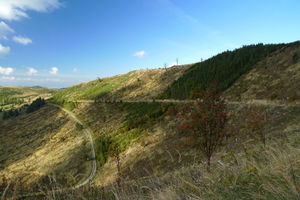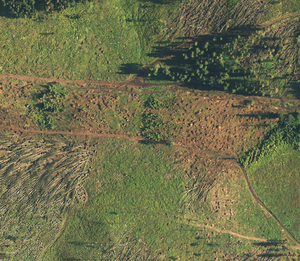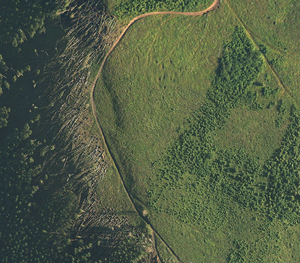Talk:Tag:man made=clearcut
Useful combinations
Is natural=scrub suitable also if there are almost no trees or bushes but predominating grass and dry branches? What about natural=heath or others? Or even without additional tag? Please see the attached pictures. --*Martin* (talk) 21:35, 22 February 2016 (UTC)
- It seems a logical approach to use natural=heath combined with man_made=clearcut in terms of size of plants but maybe not for the type of plants, it may confuse botanists? I admit I've been using it already and i came here to check if there is any discussion. I'm no woodman but i think it would be useful to have an earlier step because apparently some trees take a long time to become a shrub and then a noticeable tree.
- I take the occasion to say that in my opinion natural=scrub should have never been set to be used for clear cuts. It conflicts with the fundamental purpose of the natural=* key, meaning: elements with minimal human intervention, left to a natural ecosystem... I would prefer to use landuse=forest combined with man_made=clearcut because in essence if trees are still planted, it's still a forest. The rendering would have made it look different. ALso, it would make the mapping easier.
- - SHARCRASH (talk) 11:40, 19 April 2018 (UTC)
- For me .. a clear cut exists for some period of time. Then either the area regrows naturally,is planted out or adapted for some other purpose - like a new town. So man_made=clearcut .. well it is a form of land cover, and it should only be there for a short period of time. then it evolves in to something else like landcover=shrub (natural=shrub). I don't think dual tagging is appropriate, it is tagging for the render. Warin61 (talk) 23:16, 25 July 2018 (UTC)
- Re: natural for "elements with minimal human intervention, left to a natural ecosystem" - this isn't the meaning of natural in OpenStreetMap. Most natural=wood, natural=scrub and natural=grassland in Europe, North America and East Asia have been heavily modified by human use for the past 3000 years or more. You will be hard-pressed to find any patch of wood or forest in that has never been cut or burned by humans. The name of a key in OSM does not need to match the dictionary definition: most of the "natural=" area tags are landcovers: wood, scrub, heath, grassland, wetland (marsh/swamp/bog/mangrove), etc define the type of vegetation and the surface of the area, and do not specify how intensively humans use the area. --Jeisenbe (talk) 07:04, 26 July 2019 (UTC)
Tag not established, not proposed and not really fitting into man_made
Similarly to cutline, but significantly more, this tag does not fit well under the man_made key. The well established man_made tags are all about technical features, facilities or installations (e.g. factories, storage tanks). "clearcut" is either about an event (someone cutting trees) or about the absence of trees (someone has cut the trees). This is not the same group of things. As there also hasn't been a proposal, and usage of this tag is relatively low, with respect to all things of this type that exist on the globe and also compared to all landuse=forest or natural=tree, I suggest to make it clearer that this rather a proposal than an established feature. --Dieterdreist (talk) 15:05, 1 October 2018 (UTC)
- It may be a proposal but now there is no better tagging for clearcuts. For hiking maps it is very usefult to distinguish between forests with full-grown trees and forest with dense small scrub-like trees (impassable) or fresh clearcuts with almost no vegetation. It is sad that there is still such a mess with landuse/landcover tags. If only OSM had layers - one for landuse, other for landcover. --*Martin* (talk) 10:04, 21 January 2020 (UTC)
landuse=forest
I am one of those that think land use is for the human use of the land. As such the value forest means that the area is used to produce things for human use like timber. As such the normal harvesting operations may provide a clear cut, this is entirely normal and does not require a change to the tag of landuse=forest on the area. Warin61 (talk) 00:14, 18 August 2018 (UTC)
I agree. That does not necessarily mean that this tag should not be used at all, but there is no need to cut it out from the forest area via a multipolygon relation. Alfons234 (talk) 03:57, 2 June 2023 (UTC)
landuse=logging
I just discovered that there's also a landuse=forest tag in use, primarily in Eastern Europe and Russia. IMO man_made=clearcut is better than landuse=forest, because it describes what actually happened on the ground, rather than speculating about whether this specific clearcut is likely to be maintained for logging again in the future, or if something else will happen to it. Mappers on the ground won't necessarily know the future plans for this land. In addition, where I live in the Northwest part of North America, there are many places where the land is maintained for logging, but trees are cut down selectively, leaving most of the trees still standing, rather than cutting all the trees via a clearcut (which is also common here). In those cases of selective logging, you could conceivably have an area that should be "landuse=logging" but it's not immediately visible to the naked eye because it hasn't been fully clearcut. Again, this is a reason to prefer the more specific "man_made=clearcut" for the case when all the trees have been cut down instead of the less-specific "landuse=logging" --Alan (talk) 15:00, 1 October 2018 (UTC)
- OSM does not map a parked car, nor the harvesting of farmers fields. The tag landuse=forest can remain where logging has taken place, either selective or clear cut, just as the field after harvesting remains tagged as a farm field. Tagging man_made=clearcut tells you what was there in the past - trees, but not what is there now - scrub, soil ? Most of the time a mapper will simply see trees in these locations and can use natural=wood, only when a mapper knows that the trees will be used for some human productive purpose that the tag landuse=forest should be used. Warin61 (talk) 03:10, 22 November 2018 (UTC)
Some aerial examples of clearcut
I am attaching some aerial clearcut images to see the diversity of landcover/vegetation. Currently it is very difficult to find proper tags to map it.
--*Martin* (talk) 10:12, 21 January 2020 (UTC)
- Transiently a new clearcut might be covered in fallen logs and broken branches, but this is only temporary in most climates. In areas with long growing seasons, usually the area will be recolonised with grasses and herbs within a season, and woody shrubs will begin to grow within a couple of years. In some climate and in areas with heavy erosion, it's possible the ground will remain unvegetated for a year or more. Generally I avoid mapping vegetation which will not be around for more than a year, because I don't have time to update the tagging every few months. So I would tag the area as grass if there are non-woody herbs and grasses growing, or natural=scrub if small trees, bushes and other woody shrubs have began to grow. If no vegetation is yet growing, it would be possible to tag the bare soil, though this is not commonly done, since it usually is transient (but if the area has eroded heavily it might be worth using natural=sand/scree/clay etc.). And it's reasonable to remove the area from any surrounding natural=wood or landuse=forest area, since it is no longer covered in woodland, and usually it is not clear if the land will be reused for forestry or for something else, from aerial imagery. --Jeisenbe (talk) 12:25, 26 January 2020 (UTC)


